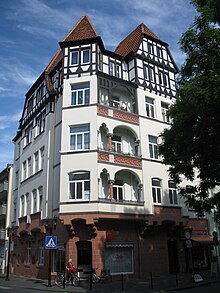Neustädter Markt (Hildesheim)
The Neustädter Markt is a historic square in the south of Hildesheim city center in the Neustadt district , where a weekly market is held twice a week.

location
The Neustädter Markt is an almost square square in the south of Hildesheim city center, which is bordered by Braunschweiger Strasse in the north and Goschenstrasse in the south . In the west it is connected to Wollenweberstraße by Enge Straße and to the north by Neustädter Stobenstraße to Braunschweiger Straße . The Neustädter Markt is one of four squares or streets in Hildesheim whose name is composed of "market". In the old town of Hildesheim, less than 1 km away, there are still the horse market and the market square as well as the old market , which was mentioned as Hildesheim's oldest street as early as 1146 under this name. The Neustädter Markt was officially given its current name on July 25, 1893.
history
As a counterpoint to the economically up-and-coming Hildesheim, the episcopal Neustadt was founded as an independent city at the beginning of the 13th century and laid out according to plan with dead straight streets. After a short time it received town and market rights , so that on the trade route to Goslar, which was called "Goslersche Strate" as early as 1317 and is now called Goschenstrasse , a place was created to hold the market. The Lamberti Church and the Neustadt town hall were built on it. The place south of the church was mentioned as early as 1320 under the name "Lamberti-Kirchhof", while the place north of the church was named "Neustädter Markt" according to a mention from 1609. After that, the square was temporarily called "Lambertsplatz", until the uniform today's name was determined for the entire square on July 25, 1893.
In 1911, construction began on a tram line that ran from today's Pelizäusplatz via Friesenstrasse, Neustädter Markt and Goschenstrasse to Südstadt . It was inaugurated on March 11, 1913 and operated as line 3 until March 22, 1945.
During the Second World War , severe damage was caused in the area of Neustädter Markt on February 22, 1945 and especially on March 22, 1945, although a fire water pond had been created in the northern part of the square: All but one of the houses and the Neustädter Town Hall were destroyed and the Lambertikirche badly damaged. Only the house at Neustädter Markt 30/31 on the corner of Goschenstrasse remained - even if it was damaged. After the war, the destroyed houses were rebuilt in the typical style of the 1950s.
Buildings and special features
A weekly market is held on Wednesdays and Saturdays at Neustädter Markt.
The Neustädter Markt is dominated and dominated by the Lambertikirche, which was built in 1474–88 in the Gothic style and rebuilt in 1950–52 after severe war damage. It forms the southern boundary of the square.
In the middle of the square is the Katzenbrunnen, it was built in 1913 based on designs by the Austrian artist Ferdinand Seeboeck . It refers to a legend according to which in the Middle Ages cats discovered a fire in the city at night and woke the population by meowing.
On the corner of Goschenstrasse rises the representative, four-storey corner house Neustädter Markt 30/31, which was the only building on the square to survive the war. It was built in 1906 and stands out for its large, distinctive bay window , balconies with arches and set columns, as well as the exposed framework on the fourth floor. This clearly sets it apart from the post-war architecture of the 1950s.
Coordinates: 52 ° 8 ′ 52 ″ N , 9 ° 57 ′ 15.5 ″ E


